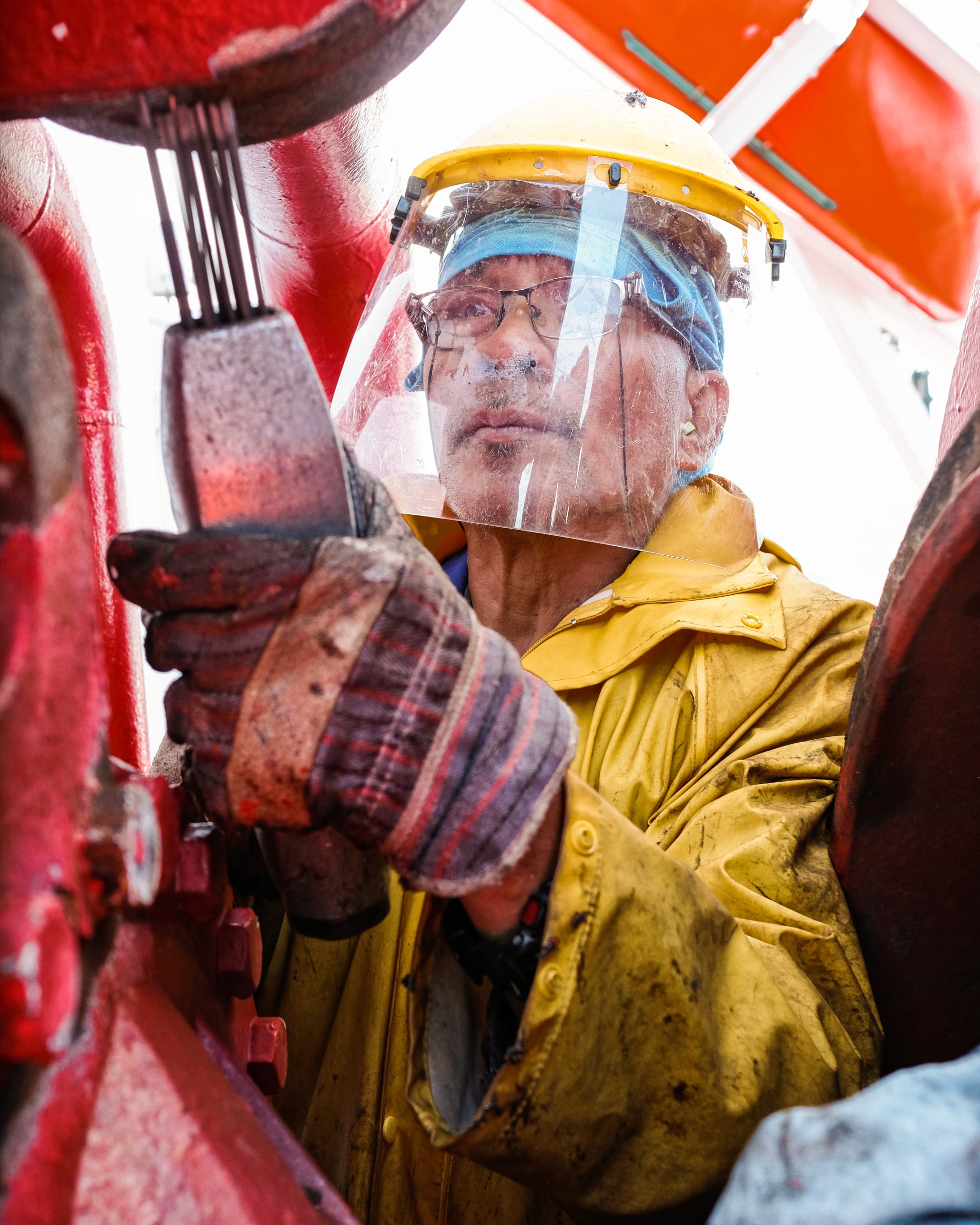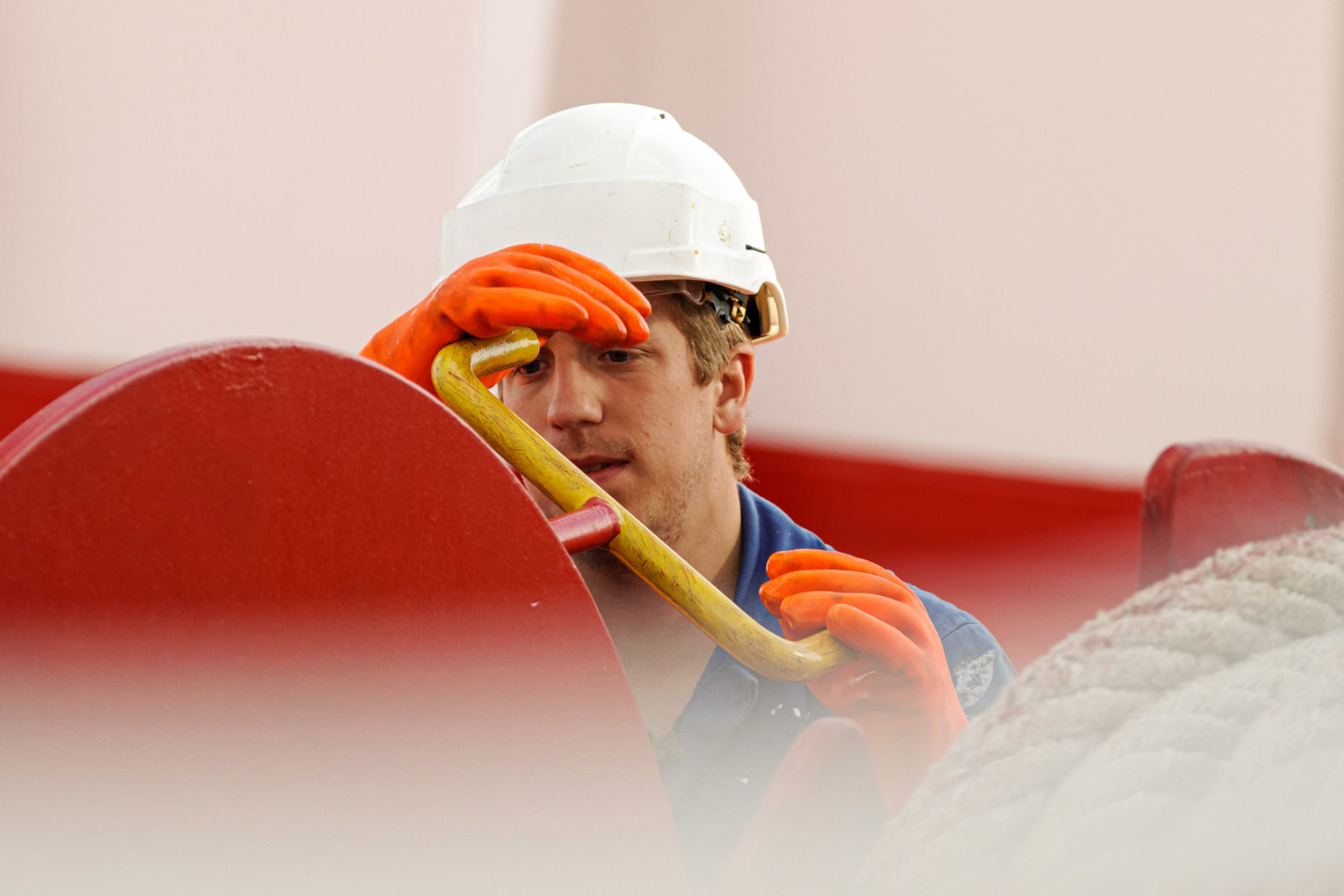PPE stands for Personal Protective Equipment. PPE exists to protect you from hazards, such as chemicals, heat and sparks, and in some cases, even coldness. PPE includes all kinds of protection that could be worn by the person performing the job. Gloves, helmets, goggles are a few of many types of PPE. Keep in mind that there is no grantee that you will not get hurt if using PPE, but most of the time, it will at least give some protection. Your employer should provide PPE to ensure your safety when working onboard.

Facial shield – Should be used together with spectacles and gives the wearer proper protection. Photo by Jörgen Språng
Gloves
The exact type of glove selected will depend on the kind of work being undertaken or the particular substance being handled, and in these cases, expert advice should be followed. The following are general rules:
- Leather gloves should generally be used when handling rough or sharp objects.
- Heat-resistant gloves should be used when handling hot objects.
- Rubber, synthetic, or PVC gloves are generally best for handling acids, alkalis, various types of oils, solvents, and chemicals in general.
Eye Protection
The leading causes of eye injury are:
- Infra-red rays – gas welding.
- Ultra-violet rays – electric welding.
- Exposure to chemicals.
- Exposure to particles and foreign bodies.
- Protectors are available in a wide variety, designed to international standard specifications, to protect against these different types of hazards.
There are mainly three different types of eye protection:
- Spectacles – Gives only limited protection. There is a risk that obstacles/splashes can hit the eye if coming from any side, below or above the wearer.
- Goggles – Gives the wearer proper protection since no obstacle/splash can hit the eye from any direction.
- Facial shield – Should be used together with spectacles and gives the wearer proper protection.
- Ordinary prescription (corrective) spectacles, unless manufactured to a safety standard, do not afford protection. Specific box-type goggles are designed so that they can be worn over ordinary glasses.
Ear Protection
All persons exposed to high levels of noise should wear ear protection of a type recommended as suitable for the particular circumstances. Protectors are of three kinds – earplugs, disposable or permanent, and earmuffs.
The earplug has the disadvantage of a limited capability of noise level reduction. Earplugs of rubber or plastic also have only limited effect, in that extremes of high or low frequency cause the plug to vibrate in the ear canal, causing a consequential loss in protection. It may be challenging to keep re-usable earplugs clean on a ship, and disposable earplugs are recommended. The earmuffs provide a more effective form of hearing protection. They are designed to completely envelop the ears, fitted with soft sealing rings to fit tightly against the head around the ears.
Safety Footwear
Foot injuries most often result from the wearing of unsuitable footwear (e.g., sandals, plimsolls, and flip-flops) rather than from a failure to wear safety shoes and boots. Safety footwear is a part of the minimum PPE required to carry on board, irrespective of in what task you are involved.
Injuries are commonly caused by impact, penetration through the sole, slipping, heat, and crushing. Safety footwear is available, which is designed to protect against these or other specific hazards identified in the risk assessment, manufactured to various standards appropriate to the particular danger involved.

The helmet is a part of the minimum PPE onboard ships and must be used in pre-defined areas. Photo by Jörgen Språng
Head Protection
Safety helmets are most commonly provided as protection against falling objects. They can also protect against crushing or a sideways blow, and chemical splashes. The helmet consists of a shell, a harness, and a crown strap. The shell protects the wearer’s head from the falling object, the harness supports the protector on the wearer’s head, and the crown strap helps to absorb the force or impact. The helmet is a part of the minimum PPE onboard ships and must be used in pre-defined areas. The helmet should be inspected and cleaned regularly. No chemicals, nor permanent marker must be used in the helmet’s shell.
Safety Harness
All personnel who are work at height, outboard, or below decks or in any other area where there is a risk of falling more than two meters should wear a safety harness (or belt with shock absorber) attached to a lifeline.
If a vessel is shipping heavy seas, nobody should be required to work on deck unless necessary. However, where this is unavoidable, persons on deck should wear a harness and, where practicable, should be secured by lifeline as protection from falls and from being washed overboard or against the ship’s structure.
Respiratory Protection
Respiratory protective equipment is essential for protection when work has to be done in conditions of irritating, dangerous, or poisonous dust, fumes, or gases. There are two main types of equipment which perform different functions:
- A respirator that filters the air before it is inhaled.
- Self Contained Breathing Apparatus (SCBA) supplies air or oxygen from an uncontaminated source.
- Respirators do not protect against an oxygen-deficient atmosphere!
- They should never be used to protect against dangerous fumes, gases, or vapors in confined spaces such as tanks, cofferdams, double bottoms, or other similar areas. Only a breathing apparatus is capable of giving protection in such circumstances.
Respiratory Protection – Respirators
There are different types of respirators available: The dust respirator gives protection against dust and aerosol sprays but not against gases. The positive pressure powered dust respirator incorporates a battery-powered blower unit, connected by a tube to the face-mask to create a positive pressure in the face-piece. This makes breathing easier and reduces face-seal leakage.
The cartridge-type of respirator consists of a full face-piece or half mask connected to a replaceable cartridge containing absorbent and a particulate filter. It is designed to protect low concentrations of certain relatively non-toxic gases and vapors. The canister-type of respirator incorporates a full face-piece connected to an absorbent contained in a replaceable canister. This type gives considerably more protection than the cartridge type.
Respiratory Protection – SCBA (Self Contained Breathing Apparatus)
When entering an oxygen-deficient atmosphere, an SCBA must be used. The apparatus is comprised of an air tank, mask, and regulator that work together to supply breathable air. Before using an SCBA, the following checks must be done:
- Check the mask for cuts, scratches, and missing buckles
- Check backpack for cuts and tears
- Check cylinder for damages
- Check hoses for cuts, cracks, and bulges
- Check regulator for damage and debris
Respiratory Protection – SCBA
When the SCBA has been done, the following checks must be carried out before entering the space:
- Perform the negative test. Block the end of the inhalation tube on the mask with your hand while trying to inhale. If fitted correctly, it will collapse against your face.
- Check the pressure in the air bottle and the audible alarm. The pressure must be at least 90% of the maximum pressure of the tube.
- Check that the regulator delivers air on inhalation without excessive effort, free flow, or fluttering.
- Perform a positive test (leak test). Breathe normally, insert a finger under the edge of the face mask. Doing this should cause a high airflow from this point.


